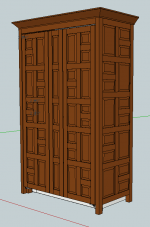I'm about to take on my first solo cabinet project. 20 years ago my father in law and I built all the cabinets for the remodel of the house my wife and I were living in. He had plenty of experience and the tools so I was along for the ride, learning the process of building cabinets carcasses from plywood, gluing up panels, raised panel construction etc. That was a great project but unfortunately it was the last thing I did in a wood shop and I didn't learn how to estimate the wood needed.
Now I have my own shop and facing another kitchen remodel. This will involve somewhat typical raised panel cabinets as well as custom panels for a sub zero fridge and an island made to look like a repurposed rustic base cabinet. Still all really just variations of the construction of common cabinets but LOTS of wood.
So what method should I use? I've seen a range of board foot overage percentages from 10-100% and higher. Some use square feet, some board feet. Some utilize Cutlist or plugins for CAD programs such as Sketchup. How do you calculate your wood needs?
As an aside, I took a cabinet making class at my local Woodcraft and I seem to recall the instructor cautioning against 4/4 wood. He advised that sufficing the wood adequately makes it difficult to end up with 3/4 stock. His advice was going with rough stock thicker than 4/4. I'd never heard that, or maybe I'm imagining I did… no matter, have you ever heard this? Do you start with more than 4/4 in your cabinet projects?
I've included the design for the Sub Zero enclosure to illustrate that part of the project.
[attachimg=1]
Now I have my own shop and facing another kitchen remodel. This will involve somewhat typical raised panel cabinets as well as custom panels for a sub zero fridge and an island made to look like a repurposed rustic base cabinet. Still all really just variations of the construction of common cabinets but LOTS of wood.
So what method should I use? I've seen a range of board foot overage percentages from 10-100% and higher. Some use square feet, some board feet. Some utilize Cutlist or plugins for CAD programs such as Sketchup. How do you calculate your wood needs?
As an aside, I took a cabinet making class at my local Woodcraft and I seem to recall the instructor cautioning against 4/4 wood. He advised that sufficing the wood adequately makes it difficult to end up with 3/4 stock. His advice was going with rough stock thicker than 4/4. I'd never heard that, or maybe I'm imagining I did… no matter, have you ever heard this? Do you start with more than 4/4 in your cabinet projects?
I've included the design for the Sub Zero enclosure to illustrate that part of the project.
[attachimg=1]


